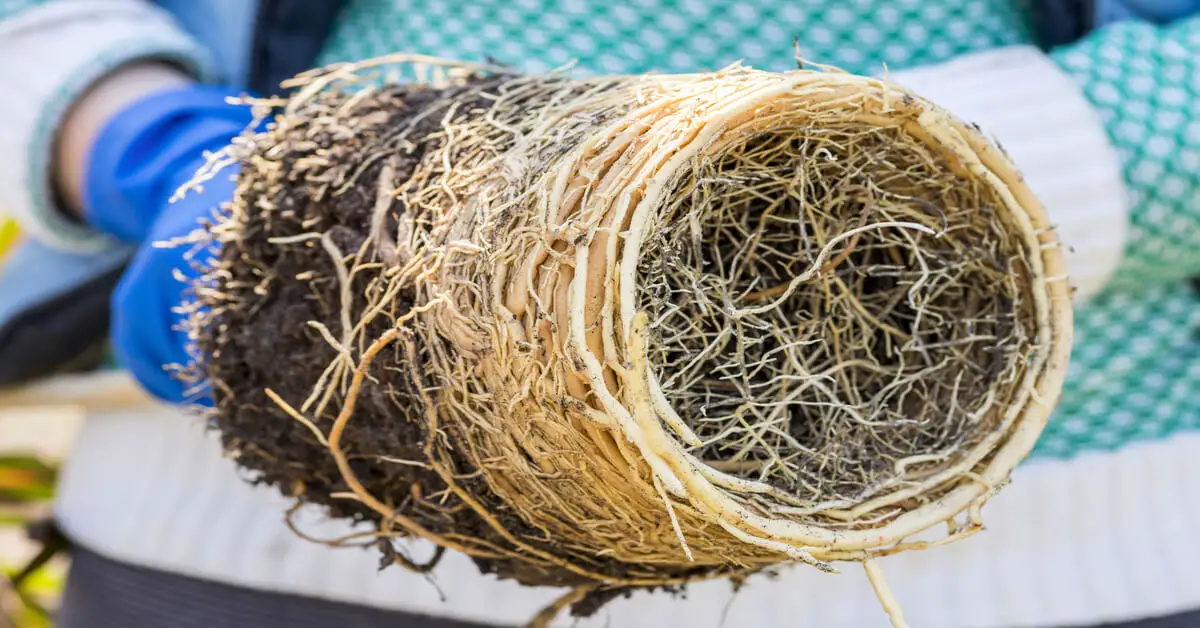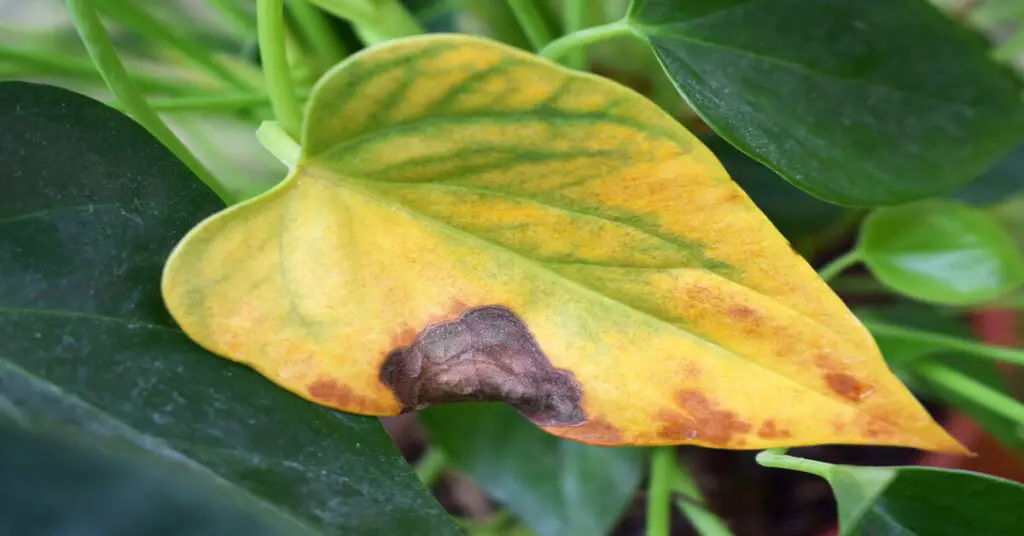There are many reasons for why your plant leaves are yellowing, and identifying the exact cause of the problem may take some time.
All plants lose leaves as part of their natural life cycle, and the odd yellow leaf here and there is not much to worry about.
However, yellowing leaves may also indicate more serious issues. So what’s really causing your plant leaves to yellow?
What is Chlorosis?
Chlorosis is the scientific term for yellowing leaves, and is caused by the lack of chlorophyll.
A little chlorosis is normal, and is even desired in the case of variegated houseplants, which owe their unique coloration to chlorosis.
In vegetables and flowering plants, however, chlorosis inhibits blooming, causes bitter-tasting fruit, and may actually kill the plant.
Yellowing leaves (or chlorosis) is hard to diagnose because there are actually a handful of reasons, many interrelated, that contribute to it.
Below, we’ll go over all the causes in detail.
9 Causes for Leaves Turning Yellow
Moisture Stress
Moisture stress – either from overwatering, underwatering, improper humidity, or improper drainage – is the leading cause of yellowing leaves.
Overwatering plants and too much humidity are bad when combined with poor drainage. As the overly wet soil drowns the roots, causing them to suffocate, shut down, and not take up essential nutrients.
Underwatering, drought, or low humidity conditions similarly affect your plant’s ability to maintain moisture and transpire (or breath). Not being able to breathe inhibits your plant’s ability to draw nutrients from the soil.
In both cases, yellowing leaves are the byproduct.
Re-pot water-logged plants in a well-draining soil and ensure pots have drainage holes. Improve aeration by adding peat, moss, sand, perlite, or vermiculite, which makes the soil less dense.
Avoid planting in areas where rainwater or irrigation builds up. And always use the “finger test” to ensure the top soil is dry between waterings.
For under-watered plants, increase waterings or add moisture via a pebble tray or humidifier. Place humidity-loving plants in high humidity locations such as a bathroom or a kitchen.
Damaged or Compacted Roots

Root damage is caused by a number of reasons, including diseases, pests, and crowded pots.
Damaged roots have difficulty absorbing water, oxygen, and nutrients, which result in yellowing leaves.
To diagnose, gently remove your plant from its pot and examine the roots. Healthy roots are whitish yellow, while damaged roots are usually a darker color and have a rotting odor.
If diseased or infested, consider buying new plants or spraying with a fungicide. For compacted roots, re-pot in a bigger pot with well-draining soil.
If root damage is minimal, consider pruning away dead or unhealthy roots before repotting.
pH Imbalances
The pH levels of soil affects your plant’s ability to absorb essential nutrients. Most plants do best in neutral to slightly acidic pH (from 6.0-7.0 pH).
Acid-loving plants such as daffodils, blueberries, azaleas, hydrangeas, and camellias, among others, do best in pH near 4.5 to 6.0.
To precisely measure soil pH, use a soil strip. However, a DIY solution is possible with households ingredients as well:
- Vinegar test: Mix together a sample of your soil in some distilled water in a container until it turns to mud. Add ½ cup of vinegar and stir mixture. If the soil fizzes, foams, or bubbles, then your soil is alkaline.
- Baking soda test: Do the same with baking soda. If the soil fizzes, foams, or bubbles, then the soil is acidic.
To make soil less acidic and increase pH (for alkaline loving plants), apply some agricultural limestone or wood ash.
To increase acidity or lower pH (for acid-loving plants), add some aluminum sulfate and sulfur, which can be purchased at most home garden stores.
Lack of Proper Nutrients
Nitrogen (N) is critical for photosynthesis and is the most important nutrient for your plant.
Nitrogen deficiency causes general yellowing, with older, inner leaves turning yellow first before affecting younger leaves.
Phosphorus (P), potassium (K), and sulfur (S) are also necessary in fairly large amounts for healthy plant growth. In container plants, these elements are sometimes leached out due to watering.
Potassium deficiencies will cause older leaves to develop yellow edges. Sulfur deficiencies will turn new leaves yellow first.
Magnesium (Mg), calcium (Ca), zinc (Zn), and iron (Fe) are also required by plants in smaller quantities and any deficiency will also turn leaves yellow. [1]
Calcium deficiencies in tomatoes, for example, will cause blossom-end rot, which causes leaves to curl inwards and turn yellow.
Fertilization alone is not enough. Be sure to also check for damaged roots, overwatering or underwatering, or pH imbalances, as all these factors affect your plant’s ability to absorb nutrients.
Overfeeding – Salt Buildup
Overfertilizing changes soil pH and may cause salts to build up in the soil. This in turn may damage and dehydrate your plant’s roots, causing yellowing and wilting leaves.
To control, manually remove or scrape as much salts from the soil as possible. Flush out salts by placing your plant under a sink.
Remember to allow water to drain well between waterings. Fertilize only during periods of active growth and consider diluting the fertilizer to half or quarter strength.
Diseases
Yellow leaves may also result from a variety of fungal and viral diseases:
- Fungal infections – Most leaf-bearing plants are susceptible to leaf spot, which is caused by a bacteria. Spots are usually brown or black with dark rings around the spots. Leaves will also turn yellow before dropping.
Early blight is also caused by a fungus in the soil, and will cause lower leaves to develop a pale-yellow spot before turning dark brown with yellow edges.
Black spots, rusts, powdery mildew, downy mildew, etc. will also cause leaves to turn yellow. Honey fungus, root rot, and verticillium wilt affect roots and can also cause leaves to yellow. [2]
- Viral infections – Mosaic virus is a common disease that affects a wide range of plants, causing leaves to turn yellow with mottled and elevated yellow, white, and green spots.
Mosaic virus is incurable, so it’s best to destroy all affected plants. To prevent, avoid insects such as aphids and leafhoppers, which carry the virus.
For fungal infections, spray with a household fungicide, soap and water, or neem oil to control spread.
Pests
Sap-sucking insects such as aphids, spider mites, mealybugs, white flies, scales, vine weevil, cabbage root fly, among others, will cause leaves to turn yellow by feeding on nutrient-rich sap.
Infested plants will usually show curling, drooping, damaged, stunted, and/or yellowing leaves.
Treat by isolating and cleaning the plants and surrounding area with insecticidal soap or mild liquid soap. Remove bugs with cotton swabs and rubbing alcohol.
To prevent pests, treat plants with neem oil, hot pepper spray, or horticultural oil.
Exposure to Herbicide
Many common herbicides or weed killers (e.g. MiracleGro) have ingredients which stop photosynthesis and chlorophyll production.
Your houseplant’s second-hand exposure may also cause leaves to turn yellow.
Improper Temperatures and Lighting
Low temperatures (usually below 10°C or 50°F) and lack of sunlight may slow down photosynthesis and chlorophyll production in plants, causing leaves to turn yellow and droop.
In the northern hemisphere, a south-facing window will receive the most direct sunlight and warmth.
Consider taking your outdoor potted plants indoors or place inside a cold frame if temperatures are too cold. Cover plants with mulch, fleece, or a cloche to retain heat.
Conversely, high temperatures will also cause water-stress, causing leaves to develop burn spots before turning yellow, wilting, and dropping.
To avoid heat stress, provide lots of shade and water during extreme heat. Consider mulching to conserve moisture and slow evaporation.
Misting will also increase humidity, helping plants breathe during high heat. Avoid fertilization or transplanting in hot summers to prevent extra stress.
References:
[1] Rahman, M. (2022, February). Nutrient deficiencies in plants. West Virginia University Extension S. Retrieved October 31, 2022, from https://extension.wvu.edu/lawn-gardening-pests/plant-disease/nutrient-deficiencies-in-plants.
[2] Unknown Author, (n.d.). Chlorosis. RHS Gardening. Retrieved October 31, 2022, from https://www.rhs.org.uk/problems/chlorosis.

